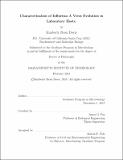Characterization of influenza A virus evolution in laboratory hosts
Author(s)
Davis, Kimberly Ryan
DownloadFull printable version (19.05Mb)
Other Contributors
Massachusetts Institute of Technology. Department of Biology.
Advisor
James G. Fox.
Terms of use
Metadata
Show full item recordAbstract
Surveillance of influenza A virus (IAV) is conducted for many different hosts including humans, swine, poultry, and wild birds. The surveillance samples are screened by various methods, but ultimately the isolates that are positive for IAV are propagated in a laboratory host prior to genome sequencing and characterization. Previous research has shown that passaging influenza viruses in laboratory hosts results in changes in viral sequence and receptor binding preferences. These studies have been limited to human IAV strains, and it remains unclear how propagation in laboratory hosts alters viruses isolated from animals. This thesis explores the evolutionary dynamics of IAV in a laboratory host environment. Chapter 2 of the thesis examines how the genomes of avian IAV strains change during a single infection in ECEs and MDCKs, and during ten serial infections in ECEs. The results from these experiments indicate that there is a wide range in the number of sequence differences between pre- and post-passaged viruses, and that sequencing viruses prior to passage results in better identification of mixed infections. The sequencing results from the serial passaged viruses show that egg adaptation is not limited to a single set of predictable changes. The results also suggest that the hemagglutinin gene is important for adaptation to a novel host environment. The aim of this thesis is to identify the changes associated with propagation of IAV in different laboratory host environments. This data can be incorporated into phylodynamic studies that track global IAV transmission through different hosts. In combination with surveillance efforts, these experiments will augment our ability to predict influenza evolution and our pandemic preparedness.
Description
Thesis: Ph. D., Massachusetts Institute of Technology, Department of Biology, 2018. This electronic version was submitted by the student author. The certified thesis is available in the Institute Archives and Special Collections. Cataloged from student-submitted PDF version of thesis. Includes bibliographical references.
Date issued
2018Department
Massachusetts Institute of Technology. Department of BiologyPublisher
Massachusetts Institute of Technology
Keywords
Biology.